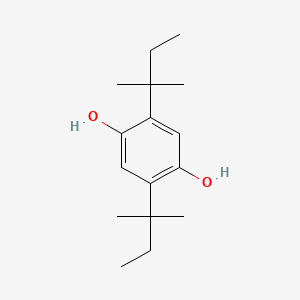D0649 | 2,5-bis(2-methylbutan-2-yl)benzene-1,4-diol
| Toxicity | Dose | Time | Species | Model | Method | Action | Positive criterion | Reference |
|---|---|---|---|---|---|---|---|---|
| MEMBRANE POTENTIAL | 6.86±3.17 | human | qHTS-HepG2 | MMP assay | decrease | IC50 | 163 | |
| MEMBRANE POTENTIAL | 3.55 | human | HepG2 | MMP assay | decrease | IC50 | 163 | |
| MEMBRANE POTENTIAL | 34.49±5.88 | rat | hepatocytes | MMP assay | decrease | IC50 | 163 | |
| Pictogram | Signal | Statements | Precautionary Statement Codes |
|---|---|---|---|
  |
Warning |
Aggregated GHS information provided by 49 companies from 5 notifications to the ECHA C&L Inventory. Each notification may be associated with multiple companies. H302 (100%): Harmful if swallowed [Warning Acute toxicity, oral] H400 (97.96%): Very toxic to aquatic life [Warning Hazardous to the aquatic environment, acute hazard] H410 (97.96%): Very toxic to aquatic life with long lasting effects [Warning Hazardous to the aquatic environment, long-term hazard] Information may vary between notifications depending on impurities, additives, and other factors. The percentage value in parenthesis indicates the notified classification ratio from companies that provide hazard codes. Only hazard codes with percentage values above 10% are shown. |
P264, P270, P273, P301+P312, P330, P391, and P501; (The corresponding statement to each P-code can be found at the GHS Classification page.) |
 |
Warning |
H371: May cause damage to organs [Warning Specific target organ toxicity, single exposure] |
P260, P264, P270, P309+P311, P405, and P501; (The corresponding statement to each P-code can be found at the GHS Classification page.) |
| 1, 2,5-bis(1,1-dimethylpropyl)- | 1,4-Benzenediol, 2,5-bis(1,1-dimethylpropyl)- | 1,4-Benzenediol,2,5-bis(1,1-dimethylpropyl)- |
| 19O4J76TTK | 2,1-dimethylpropyl)-1,4-benzenediol | 2,1-dimethylpropyl)hydroquinone |
| 2,5-Bis(1,1-dimethylpropyl)-1,4-benzenediol | 2,5-Bis(1,1-dimethylpropyl)hydroquinone | 2,5-DI(TERT-AMYL)HYDROQUINONE |
| 2,5-DI-T-PENTYLHYDROQUINONE | 2,5-Di-t-amyl-p-hydroquinone | 2,5-Di-t-amylhydroquinone |
| 2,5-Di-tert-amylbenzene-1,4-diol | 2,5-Di-tert-amylhydroquinone | 2,5-Di-tert-pentylbenzene-1,4-diol |
| 2,5-Di-tert-pentylhydroquinone | 2,5-Di-tert.-pentylhydrochinon | 2,5-Ditert-pentyl-1,4-benzenediol # |
| 2,5-bis(2-methylbutan-2-yl)benzene-1,4-diol | 2,5-di-tert-amyl-hydroquinone | 2,5-di-tert.-amylhydroquinone, AldrichCPR |
| 2456AC | 3-06-00-04748 (Beilstein Handbook Reference) | 79-74-3 |
| AB01333681-02 | ACMC-209pi3 | AI3-61041 |
| AKOS005448322 | ANW-37321 | AX8067894 |
| Antage DAH | BBL002922 | BDBM34117 |
| BRN 2214556 | CAS-79-74-3 | CHEMBL594135 |
| CTK5E7067 | CZNRFEXEPBITDS-UHFFFAOYSA-N | D0299 |
| DSSTox_CID_24992 | DSSTox_GSID_44992 | DSSTox_RID_80637 |
| DTXSID5044992 | Dahq | Diamylhydroquinone |
| EC 201-222-2 | EINECS 201-222-2 | HSDB 5231 |
| Hydroquinone, 2,5-di-t-pentyl- | Hydroquinone, 2,5-di-tert-amyl- | Hydroquinone, 2,5-di-tert-pentyl- |
| Hydroquinone,5-di-tert-amyl- | Hydroquinone,5-di-tert-pentyl- | KS-000013PB |
| LS-77297 | Lowinox AH25 | MCULE-5951023488 |
| NCGC00256161-01 | NCGC00340536-01 | NSC 455 |
| NSC-455 | NSC-6267 | NSC455 |
| NSC6267 | Oprea1_395030 | Q27252125; |
| SCHEMBL34690 | ST2415831 | STK378237 |
| Santouar A | Santovar A | T8189 |
| TC-126066 | Tox21_301767 | UNII-19O4J76TTK |
| USAF B-21 | VS-01261 | W-104259 |
| WLN: 2X1&1&R BQ EQ DX2&1&1 | ZINC394311 | hydroquinone derivative, 5a |
| CAS Number | 79-74-3 |
| PubChem Compound | 6610 |

